INCH - POUND
MIL-STD-750D
28 FEBRUARY 1995
SUPERSEDING
MIL-STD-750C
23 FEBRUARY 1983
DEPARTMENT OF DEFENSE
TEST METHOD STANDARD
SEMICONDUCTOR DEVICES
AMSC N/A FSC 5961
DISTRIBUTION STATEMENT A. Approved for public release; distribution is unlimited.
N
O
T
E
:
T
h
e
c
o
v
e
r
p
a
g
e
o
f
t
h
i
s
s
t
a
n
d
a
r
d
h
a
s
b
e
e
n
c
h
a
n
g
e
d
f
o
r
a
d
m
i
n
i
s
t
r
a
t
i
v
e
r
e
a
s
o
n
s
.
T
h
e
r
e
a
r
e
n
o
c
h
a
n
g
e
s
t
o
t
h
i
s
d
o
c
u
m
e
n
t
.
�
MIL-STD-750D
Test Methds for Semiconductor Devices.
MIL-STD-750D
1.
This Military Standard is approved
Defense.
for use by all Departments and Agencies of the Department of
2. Beneficial comments (recommendations, additions, deletions) and any pertinent data which maybe of use
in improving this document should be addressed to:
DESC-ELD, 1507 Wilmington Pike, Dayton, OH 45444-5270 by using the Standardization Document Improvement
Proposal (DD Form 1426) appearing at the end of this document or by letter.
Commander, Defense Electronics Supply Center, ATTN:
3. Entire standard revised.
ii
�
MIL-STD-750D
CONTENTS
Paragraph 1.
SCOPE - - - - - - - - - - - - - - - - - - - - - - - - - - - - - - - - - - - - - - - - - - - - - - - - -
1.1
1.2
1.2.1
1.2.2
1.3
P u r p o s e - - - - - - - - - - - - - - - - - - - - - - - - - - - - - - - - - - --
Numbering system- - - - - - - - - - - - - - - - - - - - - - - - - - - - - - - - - -
Classification of tests- - - - - - - - - - - - - - - - - - - - - - - - - - - -
R e v i s i o n s - - - - - - - - - - - - - - - - - - - - - - - - - - - - - - - - - - --
Method preference- - - - - - - - - - - - - - - - - - -- - - - - -
2.
APPLICABLE DOCUMENTS- - - - - - - - - - - - - - - - - - - - - - - - - - - - - - - - - - -
2.1
2.1.1
2.1.2
2.2
2.3
3.
3.1
3.1.1
4.
4.1
4.1.1
4.1.2
4.1.3
4.1.3.1
4.1.4
4.2
4.3
4.3.1
4.3.2
4.3.3
4.3.4
4.3.4.1
4.3.5
4.3.6
4.3.7
4.3.8
4.3.8.1
4.3.8.2
4.4
4.4.1
4.5
4.6
5.
6.
6.1
Government documents- - - - - - - - - - - - - - - - - -
Specifications, standards, and handbooks- - - - - - - - - - - - - - - - - - - -
Other Government documents, drawings, and publications- - - - - - - - - - - - -
Non-Government publications- - - - - - - - - - - - - - - - - - -
Order of precedence- - - - - - - - - - - - - - - -- - -
D E F I N I T I O N S - - - - - - - - - - - - - - - - - - - - - - - - - - - - - - - - - - - - - - - - --
Abbreviations,
symbols, and definitions - - - - - - - - - - - - - - - - - - - -
Abbreviations used in this standard- - - - - - - - - - - - - - - - - - -
GENERAL REQUIREMENTS- - - - - - - - - - - - - - - - - - - - -- - - -
Test conditions- - - - - - - - - - - - - - - - - -
Permissible temperature variation in environmental chambers - - - - - - - - - -
Electrical test frequency- - - - - - - - - - - - - - - - -
A c c u r a c y - - - - - - - - - - - - - - - - - - - - - - - - - - - - - - - - - --
Test methods and circuits- - - - - - - - - - - - - - - - -
Calibrationrequirements- - - - - - - - - - - - - - - -
Orientations- - - - - - - - - - - - - - - - - - - - - - - - -- - - - - - - - -
General precautions- - - - - - - - - - - - - - - -
T r a n s i e n t s - - - - - - - - - - - - - - - - - - - - - - - - - - - - - - - - - --
Test conditions for electrical measurements - - - - - - - - - - - - - - - - - -
Pulse measurements- - - - - - - - - - - - - - - - - - - - - -- - - - - - - - -
Test circuits- - - - - - - - - - - - - - - - - -
Test method variation - - - - - - - - - - - - - - - - - - - - - - - - - - - - -
S o l d e r i n g - - - - - - - - - - - - - - - - - - - - - - - - - - - - - - - - - --
Order of connection of leads- - - - - - - - - - - - - - -
Radiation precautions- - - - - - - - - - - - - - - - -
Handling precautions- - - - - - - - - - - - - - - - - -
UHF and microwave devices- - - - - - - - - - - - - - -
Electrostatic discharge sensitive (ESDS) devices - - - - - - - - - - - - - - -
Continuity verification of burn-in and life tests - - - - - - - - - - - - - - -
Bias interruption- - - - - - - - - - - - - - - - - - - -
Requirements for HTRB and burn-in - - - - - - - - - - - - - - - - - - - - - - -
Bias requirements- - - - - - - - - - - - - - - - - - - - -- - - - - -
DETAILED REQUIREMENTS- - - - - - - - - - - - - - - - - - - - - - - -
N O T E S - - - - - - - - - - - - - - - - - - - - - - - - - - - - - - - - - - - - --
International standardization agreement - - - - - - - - - - - - - - - - - - - -
FIGURES
Figure 1.
2.
Orientation of noncylindrical semiconductor device to direction
of accelerating force- - - - - - -- - - - - - - - - - - - - - - - - - - - - - -
Orientation of cylindrical semiconductor device to direction
of accelerating force - - - - - - - - - - - - - - -- - - - - - - - - - - - - - -
Index
Numerical index of test methods- - - - - - - - - - - - - - - - - - - - - - -
INDEX
Page
1
1
1
1
1
1
2
2
2
2
3
3
4
4
4
5
5
5
5
5
6
6
6
7
7
7
8
8
8
8
8
8
8
8
8
8
9
9
9
11
12
12
7
7
15
iii
�
�
MIL-STD-750D
1.
SCOPE
1.1 Purpose.
This standard establishes uniform methods for testing semiconductor devices, including
basic environmental tests to determine resistance to deleterious effects of natural elements and conditions
For the purpose of this standard, the
surrounding military operations, and physical and electrical tests.
term “devices” includes such items as transistors, diodes , voltage regulators, rectifiers, tunnel diodes,
and other related parts.
methods described herein have been prepared to serve several purposes:
This standard is intended to apply only to semiconductor devices. The test
a.
b.
c.
To specify suitable conditions obtainable in the laboratory that give test results equivalent to
the actual service conditions existing in the field, and to obtain reproducibility of the results
of tests.
representation of actual service operation in any one geographic location, since it is known that
the only true test for operation in a specific location is an actual service test at that point.
The tests described herein are not to be interpreted as an exact and conclusive
To describe in one standard all of the test methods of a similar character which now appear in the
various joint-services semiconductor device specifications, so that these methods may be kept
uniform and thus result in conservation of equipment, manhours, and testing facilities. In
achieving this objective, it is necessary to make each of the general tests adaptable to a broad
range of devices.
The test methods described herein for environmental, physical, and electrical testing of devices
shall also apply, when applicable, to parts not covered by an approved military sheet-form
standard, specification sheet, or drawing.
1.2 Numbering system.
following system:
The test methods are designated by numbers assigned in accordance with the
1.2.1 Classification of tests.
The tests are divided into five areas. Test methods numbered 1001 to
1999 inclusive, cover environmental tests; those numbered 2001 to 2999 inclusive cover mechanical-
characteristics tests.
covers tests for transistors and 4001 to 4999 covers tests for diodes.
inclusive are for high reliability space applications.
Electrical-characteristics tests are covered in two groups; 3001 to 3999 inclusive
Test methods numbered 5000 to 5599
1.2.2 Revisions.
Revisions are numbered consecutively using a period to separate the test method number
and the revision number.
For example, 4001.1 is the first revision of test method 4001.
1.3 Method of reference.
When applicable, test methods contained herein shall be referenced in the
individual specification by specifying this standard, the method number, and the details required in the
summary of the applicable method.
To avoid the necessity for changing specifications that refer. to this
standard, the revision number should not be used when referencing test methods.
4001.1.
For example, use 4001, not
1
�
MIL-STD-750D
2. APPLICABLE DOCUMENTS
2.1 Government documants.
2.1.1 Specifications, standards, and handbook. The following specifications, standards, and handbooks
form a part of this document to the extent specified herein.
Unless otherwise specified, the issues of
these documants are those listed in the issue of the Department of Defense Index of Specifications end
Standards (DODISS) and supplement thereto, cited in the solicitation (see 6.2).
SPECIFICATIONS
MILITARY
MIL-S-19500
- Semiconductor Devices, General Specification for.
STANDARDS
MILITARY
MIL-STD-12
- Abbreviations for used on Drawings, Specification Standards & in Technical
Docunents
MIL-STD-202 - Test Methods for Electronic and Electrical Component Parts.
MIL-STD-45662 - Calibration Systems Requirements.
MIL-STD-1686 - Electrostatic Discharge Control Program for Protection of Electrical and
Electronic Parts, Assemblies and Equipment (Excluding Electrically Initiated
Explosive Devices) (Metric).
HANDBOOKS
MILITARY
MIL-HDBK-263
- Electrostatic Discharge Control Handbook for Protection of Electrical and
Electronic Parts, Assemblies and Equipment (Excluding Electrically Initiated
Explosive Devices) (Metric).
(Unless otherwise indicated, copies of federal and military specifications, standards, and handbooks are
available from the Defense Printing Service Detachment Office, Bldg. 4D (Customer Service), 700 Robbins
Avenue, Philadelphia, PA 19111-5094.)
2.1.2 Other Government documents. drawings. and publications.
The following other Government documents,
drawings, and publications form a part of this document to the extent specified herein. Unless otherwise
specified, the issues are those cited in the solicitation.
DRAWINGS - JAN
103-JAN
107-JAN
118-JAN
124-JAN
152-JAN
174-JAN
231-JAN
233-JAN
234-JAN
236-JAN
256-JAN
266-JAN
- Filter for Testing Crystal Rectifier 1N23, 1N23A and 1N23B.
- Mixer for Testing Crystal Rectifier Type 1N26.
- Figure of Merit Holder for Crystal Rectifier 1N31.
- Mixer and Coupling Circuit for Crystal Rectifiers 1N21B.
- SA Band Crystal Detector Test Holder.
- Mixer for Electron Tube Type 1NS3.
- Burn Out Testing Equipment for 1N25 Crystals Schematic Diagram.
- Loss Measuring Equipment for 1N25 Crystals Schematic Diagram.
- Loss Measuring Equipment for 1N25 Crystals Bill of Material.
- Burn Out Testing Equipment for 1N25 Crystals Bill of Materials.
- Reverse Pulse Recovery Time Test and Calibration Procedure.
- Mixer Holder, Narrow, Band, for 1N263.
DRAWINGS - DESC
ASSEMBLY
D641OO
C64169
C65017
D65019
C65042
D65064
C65101
C66053
B66054
C66058
- Diode Test Holder, 3,060 MHz (S-Band).
- Sliding Load (S-Band) Used with D641OO.
- Assembly, Tri-polar Diode Holder.
- Diode Test Holder, 9,37S GHz (X-Band).
- Sliding Load (X-Band) Used with D65019.
- Diode Test Holder, 16 GHz (Ku-Band).
- Sliding Load (Ku-Band) Used with D65064.
- Mixer Holder, Narrow Band, for 1N1838.
- Adaptor For Burn-Out Test.
- Burn-Out Tester For Microwave Diodes.
2
�
MIL-STD-750D
(Copies of drawings may be obtained from the Defense Electronics Supply Center, Directorate of Engineering
Standardization (DESC-ELST), 1507 Wilmington Pike, Dayton, Ohio 45444.
drawings, both the identifying symbol number and title should be stipulated.)
When requesting copies of these
2.2 Non-Government publications.
The following documents form a part of this document to the extent
specified herein.
listed in the
listed in the
Unless otherwise specified, the issues of the documents which are DoD adopted are those
DODISS cited in the solicitation.
DODISS are the issues of the documents cited in the solicitation (see 6.2).
Unless otherwise specified, the issues of documents not
Standard
Handbook for Electrical Engineers.
(Application for copies should be addressed to the McGraw-Hill Book Company, Inc., New York, N.Y. 42840.)
NBS Handbook 59
- Permissible Dose From External Sources of Ionizing Radiation, Recommendations of
NBS Handbook 73 - Protection Against Radiations from Sealed Gamma Sources.
NBS Handbook 76
- Medical X-Ray Protection Up to 3 Million Volts.
National Committee on Radiation Protection.
(Application for copies should be addressed to the Superintendent of Documents, Washington, DC 20402.)
2.3 Order of precedence.
cited herein, the text of this document takes precedence.
applicable laws and regulations unless a specific exemption has been obtained.
In the event of a conflict between the text of this document and the references
Nothing in this document, however, supersedes
3
�
3.1 Abbreviations. symbols, and definitions.
symbols, and definitions specified in MIL-S-19500, MIL-STD-12, and herein shall apply.
MIL-STD-750D
3. DEFINITIONS
For the purposes of this standard, the abbreviations,
3.1.1
Abbreviations used in this standard.
Abbreviations used in this standard are defined as follows:
a.
b.
c.
d.
e.
f.
g.
h.
i.
j.
k.
l.
m.
n.
o.
p.
q.
r.
s.
t.
u.
v.
w.
x.
ATE
BIST
DPA
DUT
ESD
ESDS
FET
FIST
FWHM
HTRB
IF
IGBT
LCC
LINAC
MOSFET
PIND
RH
SEM
SOA
SSOP
STU
SWR
TLD
TSP
.
.
.
.
-
.
.
.
.
.
.
.
.
.
.
.
-
.
.
.
Automatic test equipment.
Backward instability shock test.
Destructive physical analysis.
Device under test.
Electrostatic discharge.
Electrostatic discharge sensitivity.
Field-effect transistor.
Forward instability shock test.
Full-width half-max.
High temperature reverse bias.
Intermediate frequency.
Insulated gate bipolar transistor.
Leadless chip carrier.
Linear accelerator.
Metal oxide semiconductor field-effect transistor.
Particle impact noise detection.
Relative humidity.
Scanning electron microscope.
Safe operating area.
Steady-state operating power.
Sensitivity test unit.
Standing wave ratio.
Thermoluminescence dosimetry.
Temperature sensitive parameter.
4
�
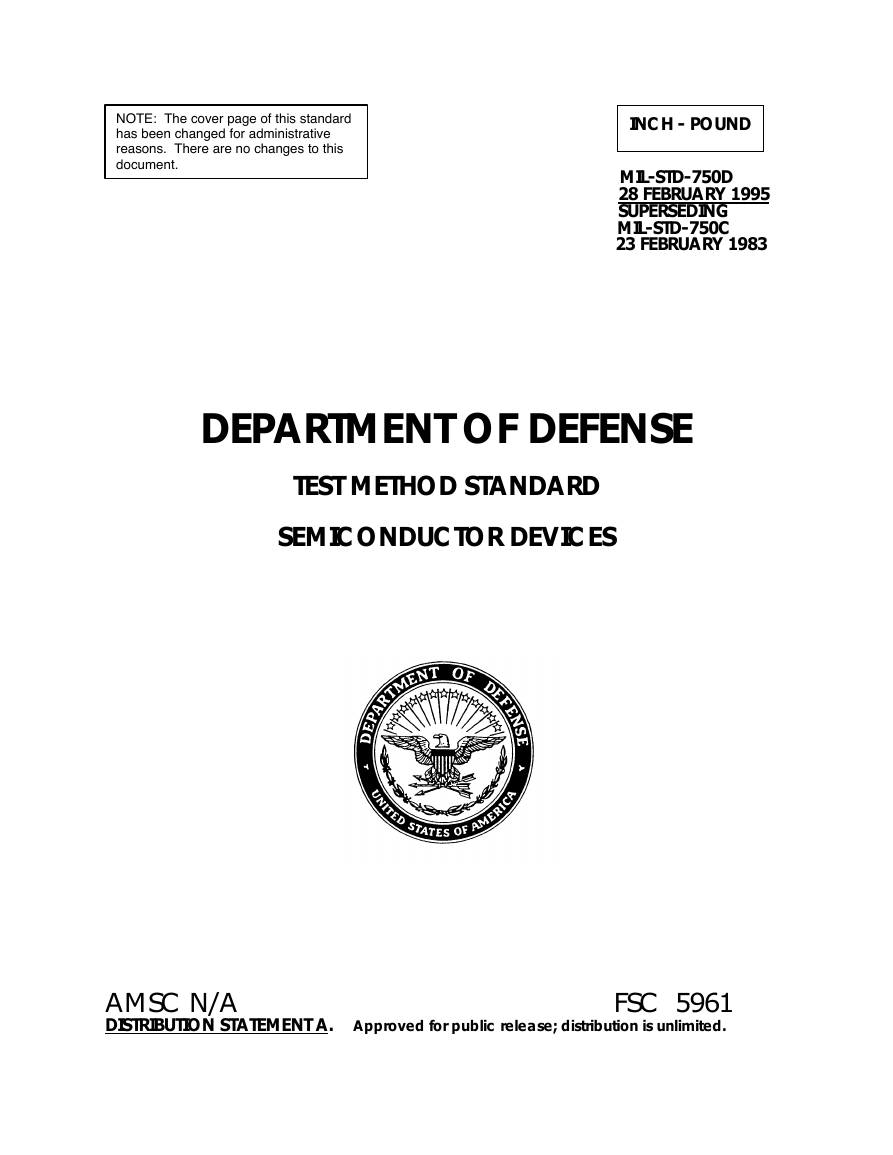
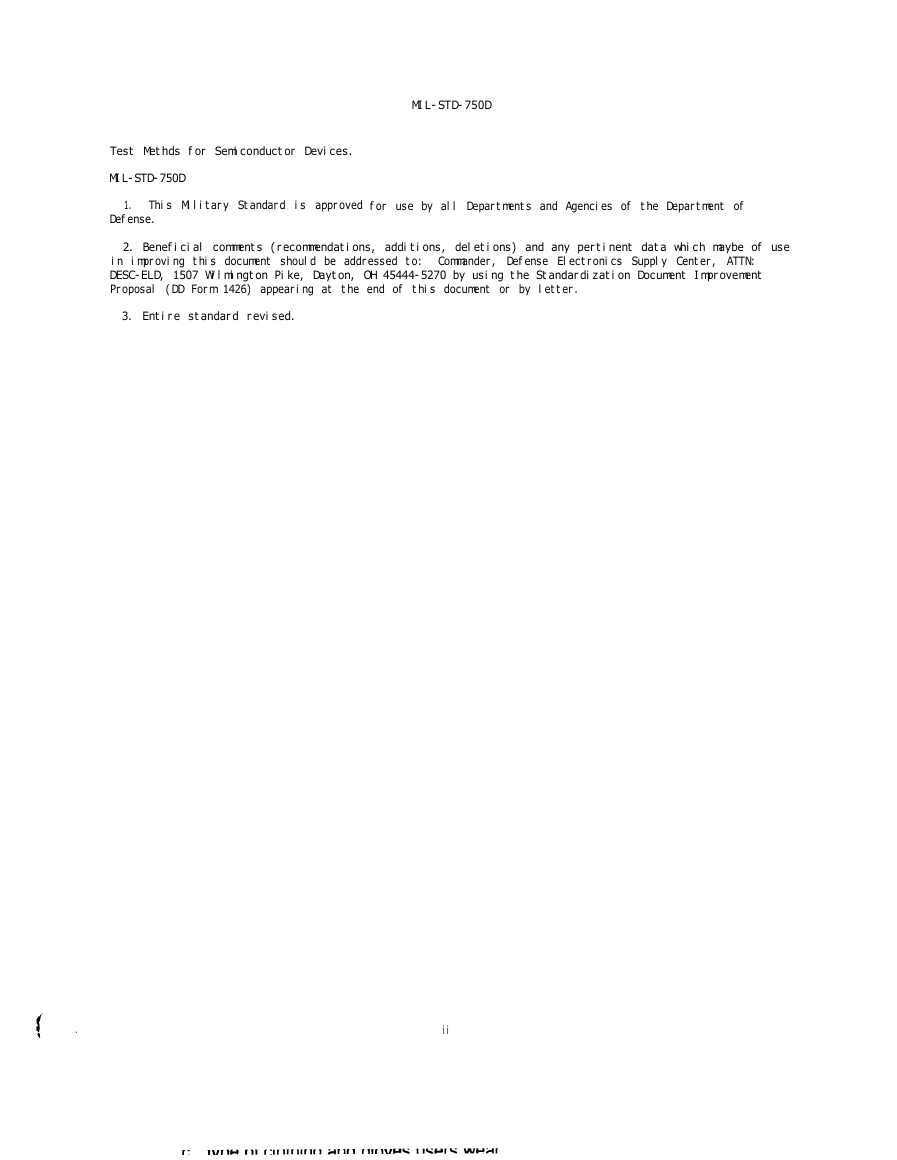
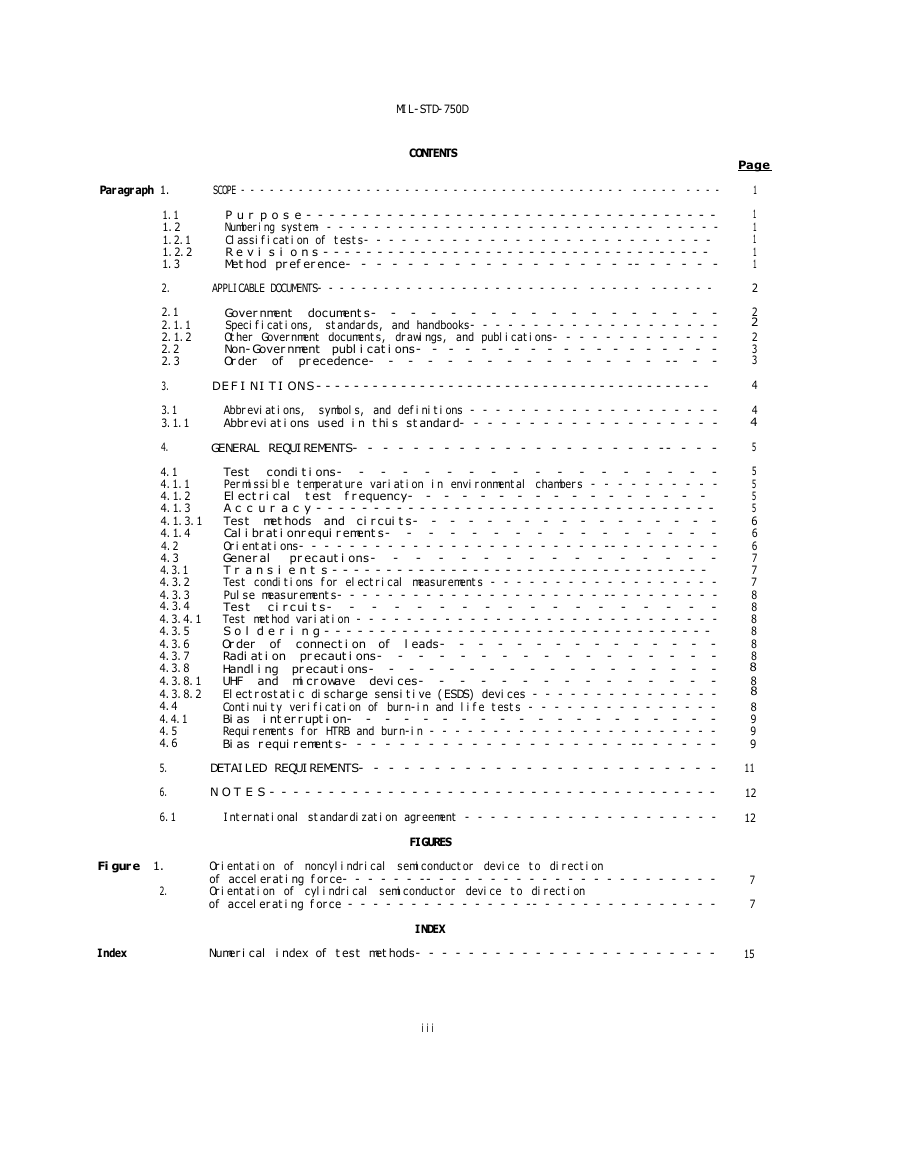

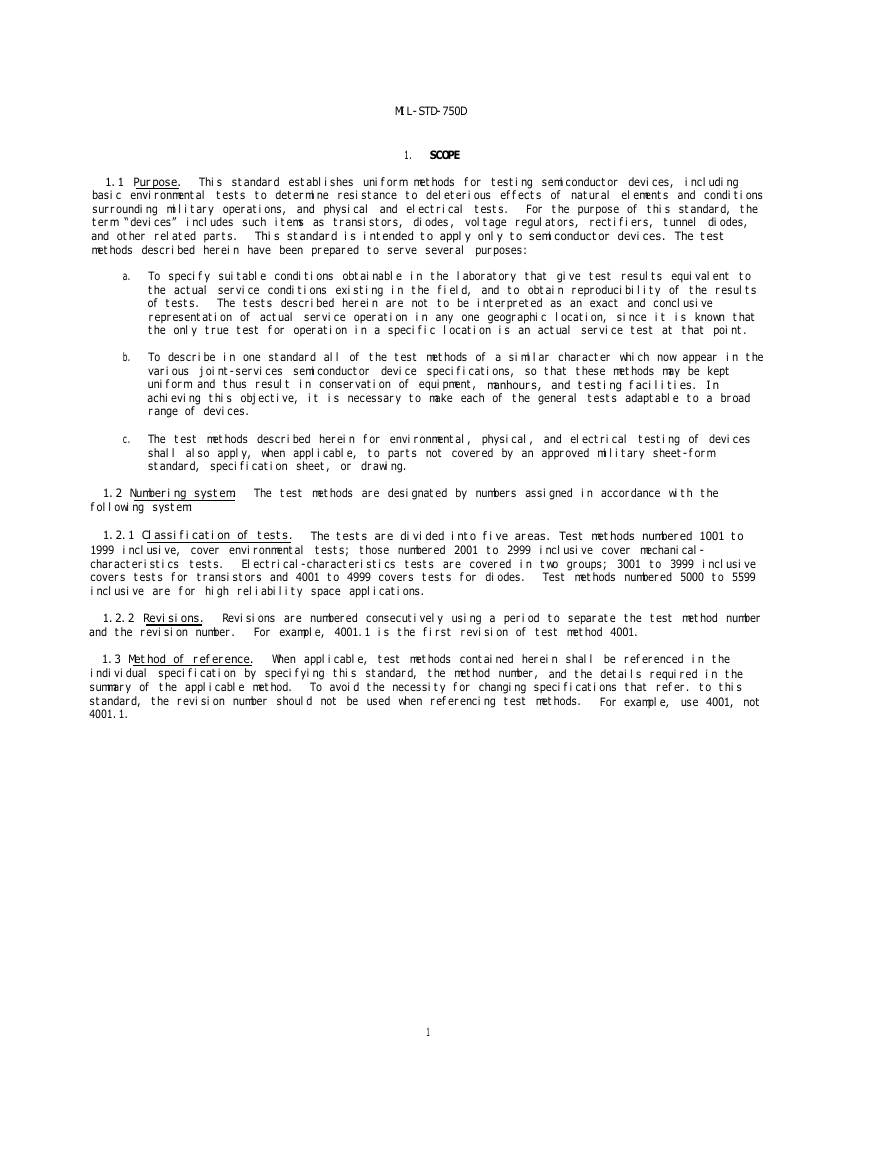
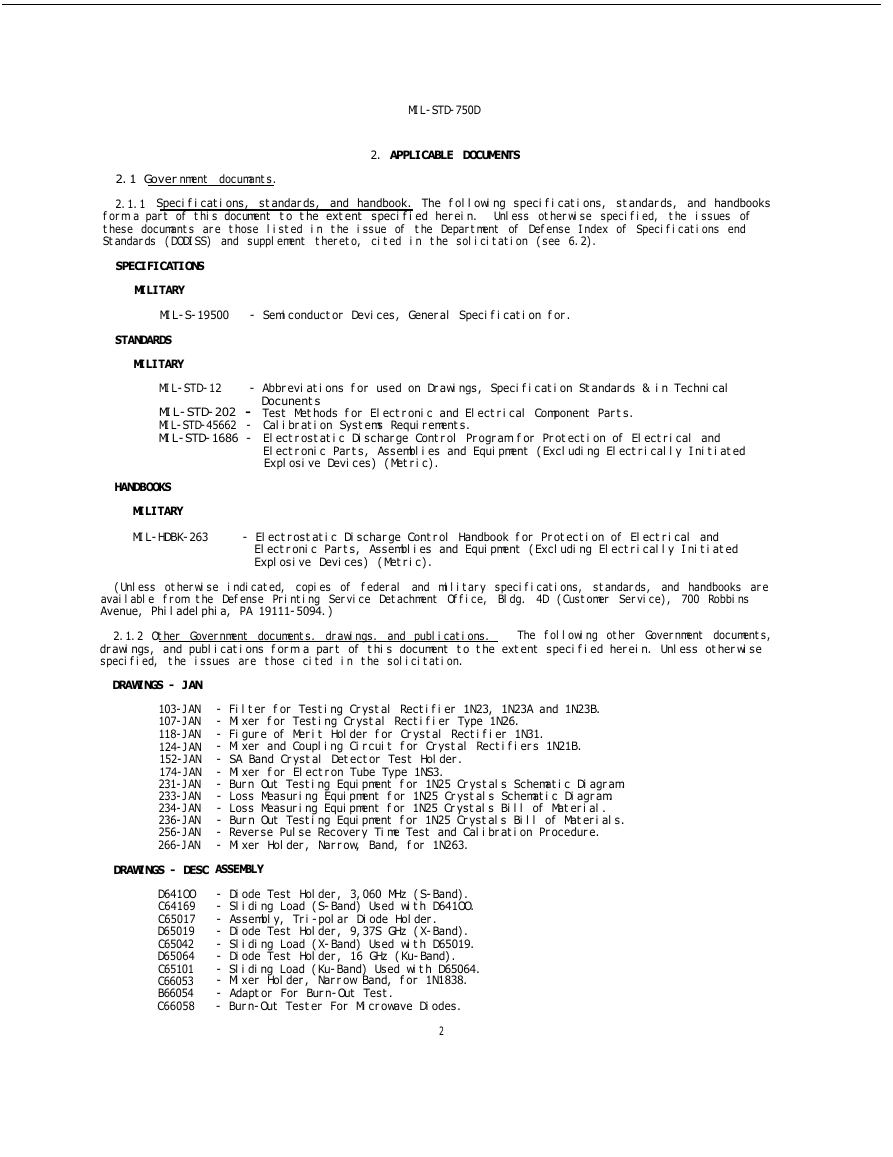
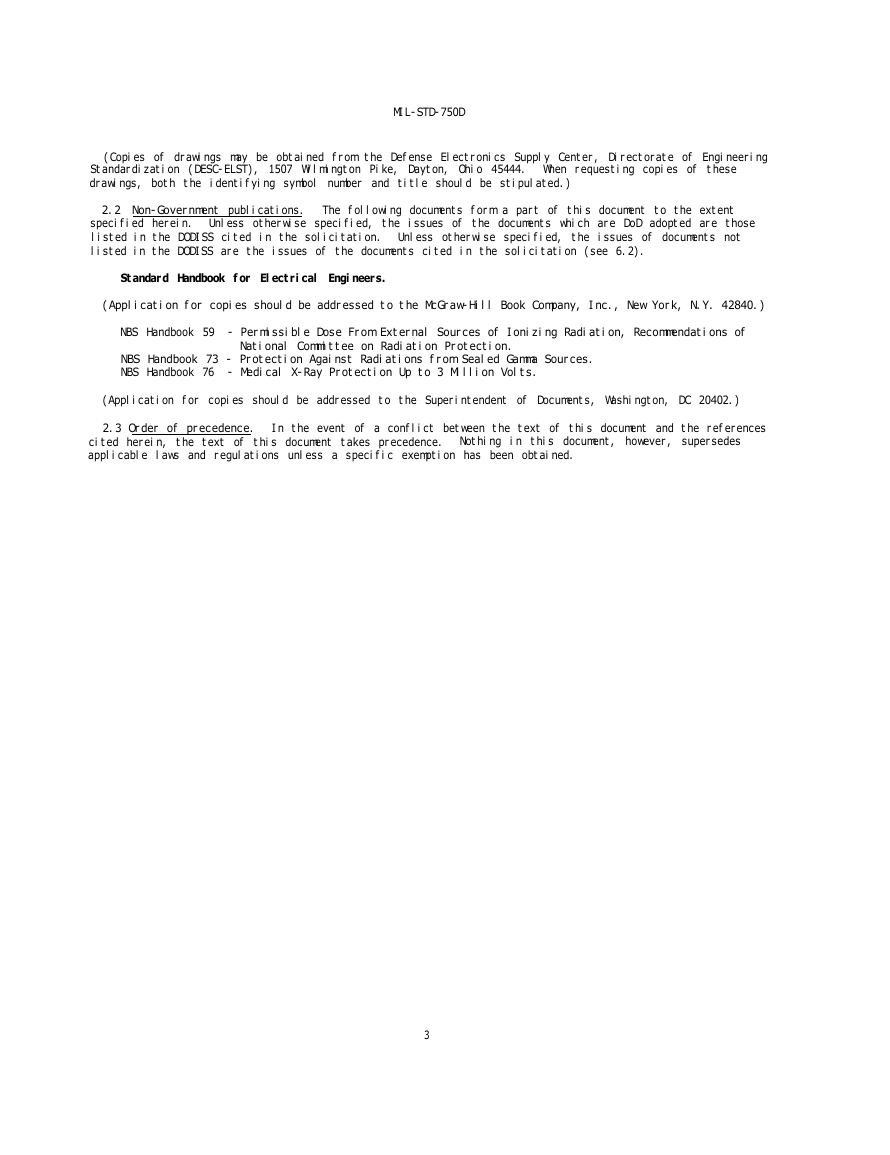
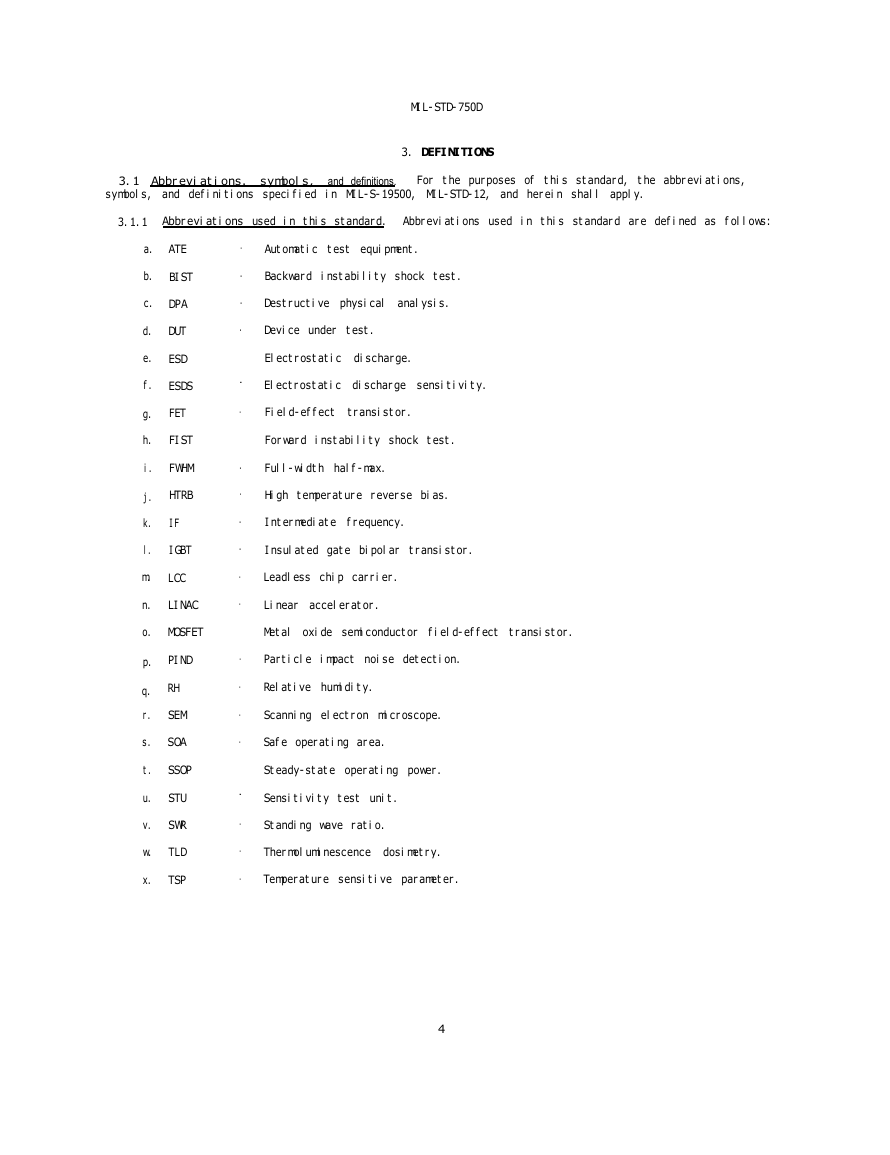








 2023年江西萍乡中考道德与法治真题及答案.doc
2023年江西萍乡中考道德与法治真题及答案.doc 2012年重庆南川中考生物真题及答案.doc
2012年重庆南川中考生物真题及答案.doc 2013年江西师范大学地理学综合及文艺理论基础考研真题.doc
2013年江西师范大学地理学综合及文艺理论基础考研真题.doc 2020年四川甘孜小升初语文真题及答案I卷.doc
2020年四川甘孜小升初语文真题及答案I卷.doc 2020年注册岩土工程师专业基础考试真题及答案.doc
2020年注册岩土工程师专业基础考试真题及答案.doc 2023-2024学年福建省厦门市九年级上学期数学月考试题及答案.doc
2023-2024学年福建省厦门市九年级上学期数学月考试题及答案.doc 2021-2022学年辽宁省沈阳市大东区九年级上学期语文期末试题及答案.doc
2021-2022学年辽宁省沈阳市大东区九年级上学期语文期末试题及答案.doc 2022-2023学年北京东城区初三第一学期物理期末试卷及答案.doc
2022-2023学年北京东城区初三第一学期物理期末试卷及答案.doc 2018上半年江西教师资格初中地理学科知识与教学能力真题及答案.doc
2018上半年江西教师资格初中地理学科知识与教学能力真题及答案.doc 2012年河北国家公务员申论考试真题及答案-省级.doc
2012年河北国家公务员申论考试真题及答案-省级.doc 2020-2021学年江苏省扬州市江都区邵樊片九年级上学期数学第一次质量检测试题及答案.doc
2020-2021学年江苏省扬州市江都区邵樊片九年级上学期数学第一次质量检测试题及答案.doc 2022下半年黑龙江教师资格证中学综合素质真题及答案.doc
2022下半年黑龙江教师资格证中学综合素质真题及答案.doc